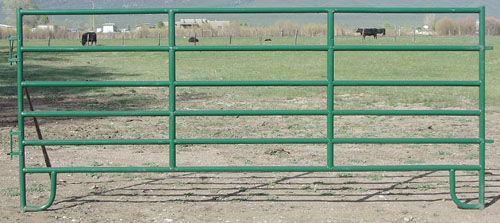So You're New To Goats (Part 1)
by Gary Pfalzbot
January 12, 2002 - (revised, March 7, 2015)
About the Author
So You're New To Goats? or perhaps you are planning on getting goats (and haven't yet)? Let's talk about some of the immediate things to be aware of - shelter, fencing, health requirements, a breed or breeds to start with, and the ultimate purpose for getting goats (pet, dairy, meat, fiber, brush control, showing, etc.).
For ourselves, we got goats for one purpose only - to control brush. We had no idea what was going to be involved with raising and caring for goats. In other words, we got the goats first and then did the research. This is not an approach I would recommend to beginners.
As a young boy, I had gained some experience with goats: 4H, showing, milking as well as the care and feeding of them. Yet, when it came to actually starting my own goat farm, I found that I had a lot to learn. From that day forward, I created the GoatWorld web site and began building an extensive collection of experiences and opinions along the way.
Fencing, Electric Fencing
First and foremost (at least in my opinion) is fencing. If you don't have adequate fencing, you will be fighting a losing battle. Your goats will be everywhere except where you do not want them. There are a few different schools of thought on fencing, each a separate topic in its own right. And a prospective goat owner should take note - install your fencing before you get goats. Otherwise you'll find yourself fighting the losing battle I spoke of.
First you have electric fencing. Some will say this is cruel - cruel is a neighbor shooting or turning their dogs loose on your "out of control" goats that have just munched down their garden.
Electric fencing can work, but one needs to really understand the concept of building a tight electric fence, good corners and good materials. In my opinion, the thicker and tighter the electric fence wire, the better. I have seen fences of three strands of wire adequately contain goats of a certain size. If you have a mixed size herd, i.e., Pygmies, Saanens, Nubians, kids, I strongly feel you may need more strands of wire because the smaller goats will go under or over the very bottom wire while the larger and taller goats may be inclined to jump over the middle or uppermost wire.
The charger itself should be of good quality - many report that solar chargers work well. We personally use a Par-Mac charger that delivers 10kV (10,000 volts) of what is pretty much a "static" electricity shock - pulsating. Also to be included with this type of set-up is a good grounding system that ensures that the fence charger delivers that 10kV at any point in the electric fence line. A poor grounding system will not go very far in detering a goat from going through it.
Since my first writing of this article, I have revised my thoughts on fence chargers somewhat...there are two that I don't recommend that a person use. The first is the type that is used for dogs. These are generally much cheaper (thus an enticement to a prospective buyer) than what I call "official livestock fence chargers". These dog chargers just don't produce enough zap to effectively deter a goat from crossing through. The second type of charger is a solar charger. This is not to say that ALL solar chargers are a no-no. Some of them may address my concerns...solar chargers seem to have a slower recharge rate, meaning that there is a time lapse from when the electric fence is hot, and when it is not. Also of concern is that the zap is also not enough to deter a goat from crossing through. Some of the higher end solar chargers may work, but the ones I've had experience with thus far, don't.
Panel Fencing
An alternative to electric fencing is the use of "cattle" or "hog" panels. These can be used with great success but there are a couple of drawbacks. First, cattle panels come in 16 foot lengths and cost anywhere from $11 to $14 each (as of 2013 they are a lot more than that). The difference between a "cattle" and "hog" panel is the height and the spacing of the squares in the panel. Cattle panels are approximately 5 feet high and each square is approximately 6 inches by 6 inches. Hog panels stand about 3 feet high and while the top squares are 6 by 6, the lower to the ground the hog panel gets, the smaller the squares get.
Corral Panels/gates are a bit different story. They do cost much more than cattle or hog panels, but are easily moveable and more ideal for rotating goats (and other livestock) to different areas. However, it should be noted that goats of smaller size can easily wiggle their way through the spaces, and goats of larger size will often lift up the bottom of this type of panel. Don't put anything past a goat. If there is an opening in a panel or fence, they will try to get through it!

Cattle Panel
| |

Corral Panel
|

Hog Panel
|
Personally I have found cattle panels to be highly useful for larger goats while the hog panels are more suitable for kid goats (who can often squeeze through 6 by 6 squares on the larger cattle panels). Conversely, larger goats can (and often will) jump over the 3 foot high hog panels. The other drawback to both cattle and hog panels is that if you have horned goats, they may be likely to stick their head through the 6 by 6 squares and get stuck in them. On the other hand, cattle and hog panels do offer the ability of being able to move a fence-line or goat pen. They are very durable and besides adding a few corner t-posts for support, all that is needed is a bit of bailing wire or bailing string to lash them together. I have even seen and used myself, the smaller hog panels with an electric wire above the top of the panel to deter jumpers.
Another fencing alternative is "woven wire". Personally I don't like this method because for one thing, it becomes a permanent fence for the most part and woven wire also has either 4 x 4, 5 x 5, or 6 x 6 inch squares - again, goats can and do get caught in this set-up. Also, it's a real task to get a woven wire fence tight which is a key to building a good goat fence. But some do use woven wire with excellent results.
Another (and more expensive) alternative is using chain link fencing. This is probably the most secure method there is but then who can afford to fence an acre or more with chain link fencing? This kind of fencing would be ideal for smaller goat pens for breeding, holding, sick or kidding pens.
Two more types of fencing are widely used with great results - again they are more expensive. Wooden and metal fencing. Both types require that you have fence rails of either material spaced just right so the goats cannot slip through them. Best if fashioned after the cattle and hog panels in heigth of railing. Metal tubing is ideal. Wooden is equally effective - the only drawback being that goats will tend to rub and gnaw at certain types of wood - you may be replacing sections of wooden fence railing more often than you'd like to.
So now that I've discussed some "basics" of fencing, let's hear what kind of fencing you've come up with. Perhaps you have a few questions about fencing. I'm not the ultimate authority on the subject but I'm sure many of the other members have their own experiences and wisdom to share.
Looking back on this article now, I realize that I have mainly skimmed the very first part of being "new to goats". I may have originally done this to stress the importance of fencing. While fencing is certainly important and should not be overlooked, I now realize that I've left new goat owners, or prospective new goat owners out in left field by not following up with the next area of actually being new to goats. You might find what you are looking for in Part 2.

|
About the author: Gary Pfalzbot is a Service Connected Disabled Veteran and the web master of GoatWorld as well as some other web sites. He has raised goats over the years, been involved with 4-H (as a young boy) and currently resides in Colorado where he and his wife Pam raise a few breeds of goats and other animals, and primarily author the GoatWorld web site to continue to inform, educate, and promote the industry.
|
|










